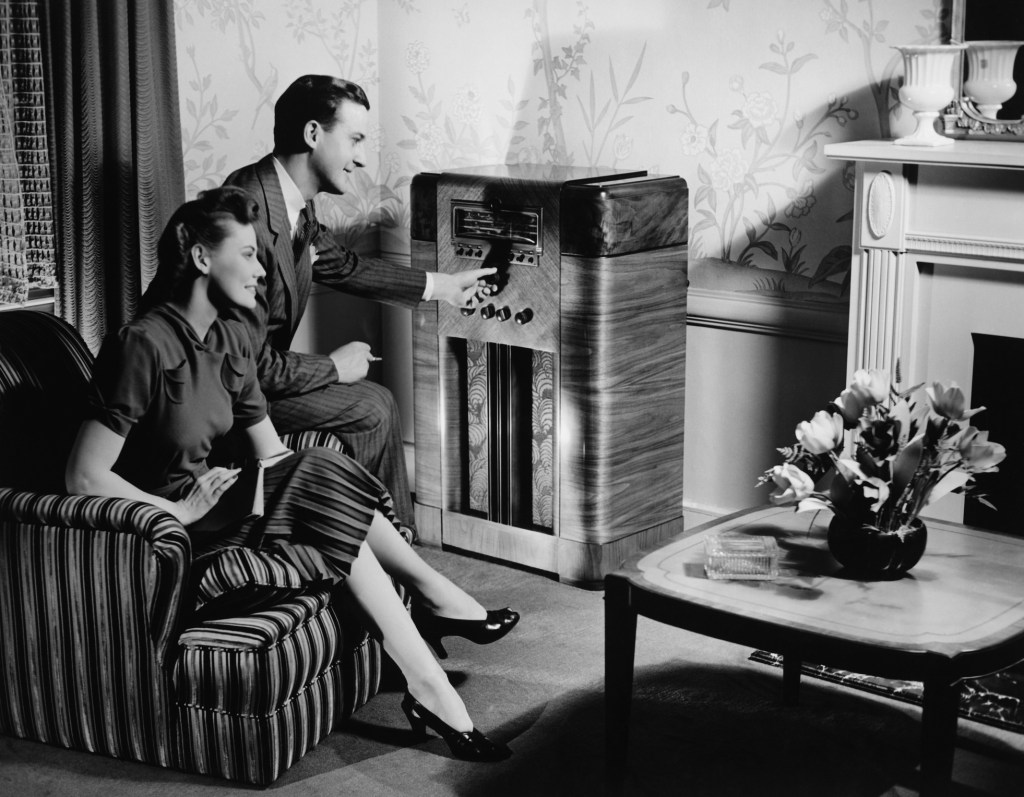The oldest continuously operating FM radio station in Los Angeles is KRTH (101.1 FM).
The original FM band was different than it is today, spanning 42-50 MHz rather than today’s 88-108. FM broadcasting on the original band was launched on January 1, 1941; the genesis of KRTH, known at the time as K45LA, signed on the air August 11, 1941, at 44.5 on the FM dial – the first FM station in town.
In 1945, the Federal Communications Commission began migrating the FM broadcast band to its current spectrum, an action that was completed by early 1949. K45LA, which by 1943 was known as KHJ-FM, the sister station to KHJ (930 AM), moved to 99.7 on the new band in 1946. In 1947, it moved to its current home of 101.1.
Information regarding programming during the early days of KHJ-FM is lacking. I’ve read that it was essentially a simulcast of KHJ’s AM station, including the first few years of Boss Radio KHJ that launched in 1965.
That there are so many recordings of KHJ-AM and so few of the FM simulcast is telling. People just didn’t listen to FM in the early days. And why would they? AM radios were everywhere, and if the programming was the same, what difference did it make?
In order to help FM compete, the FCC ruled that beginning in 1968, co-owned AM/FM combos could not simulcast full-time. KRTH thus launched “Hit Parade ’68,” an automated solid-gold oldies format playing songs within a few years of 1968. It became “Hit Parade ’69” in 1969 and then just “Hit Parade” in 1970. In 1971, there was a new, but similar, format: Solid Gold Rock and Roll. There are some recordings of all of these around the internet if you’re interested… just search “KHJ-FM.”
Then came late 1972. In a nod to Earth Day, KHJ-FM changed call letters to “K-Earth” KRTH, and launched its own format. It was still automated, but the sound was updated with new jingles and a focus on the early years of rock and roll, generally 1955-1965. This made for a perfect complement to KHJ, which played current music along with oldies going back to roughly 1965.
I am told that the original format was not going to be oldies, but more of a folk-based singer/songwriter sound, matching the vibe of the hippy movement. Only insiders would know for sure, but it does make a certain amount of sense.
The timing of the change was perfect. Suddenly, the 1950s and ‘60s were part of pop culture … The movie “American Graffiti” and then the launch of “Happy Days” on ABC television helped build on the nostalgia of the era, and KRTH was right there playing the music.
KRTH evolved with the times. As the years progressed, newer music was added. I personally think KRTH was at its peak in the late 1970s until the mid-’80s when it played current music as well as oldies, with special weekends called things like “Souvenir of the ’70s” and the “Runners-up of rock and roll.” This was the era of live DJs such as Pat Evans and Brian “Mr. Rock and Roll” Beirne; London and Engelman were the morning team during part of this era, until being hired away for mornings on the new top-40 K-WEST (now KPRW, 105.9 FM) in 1981.
KRTH continued to evolve, going back to full-time oldies in 1984, but adding more recent music. This not only kept the station fresh, but it also brought in new (and younger) listeners. While many lament that the station no longer plays music from the first years of rock and roll, it must be noted that in 1972, the oldest song KRTH played was 17 years old … 19 of you count the few songs that reached back to 1953.
Compare that with today, in which KRTH’s playlist focuses on the 1980s and reaches into the early 2000s … meaning the majority of songs are at least 35 years old, and the most recent are at least 20.
Jingles have changed with the times as well, as have personalities. The idea is to stay fresh and relevant, and the results speak for themselves. KRTH is currently the most popular station in Los Angeles – by a long shot.
In the July Nielsens, KRTH was more than a point above second-place KOST (103.5 FM), earning a 7.4 share vs. KOST’s 6.1 among all listeners aged 6 and over. It also led in almost every demographic. That’s not luck, that’s good programming, under the direction of Chris Ebbott. I believe it is KRTH’s highest rating – ever.
This good programming includes an excellent air-staff: Gary Bryan and Lisa Stanley in the morning, followed by Lara Scott, Greg Simms and Larry Morgan weekdays; Kevin Schatz, Renee Taylor and Dave Styles weekends and fill-ins. All are entertaining and excellent musical hosts. Contests are fewer than in years past, but the on-air presentation overall is superb.
You can’t argue with success, and KRTH is definitely a success, more today than ever.
Richard Wagoner is a San Pedro freelance columnist covering radio in Southern California. Email rwagoner@socalradiowaves.com
Originally Published: August 25, 2025 at 7:00 AM PDT
